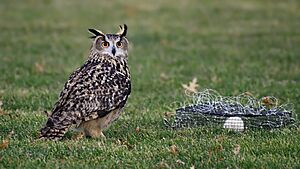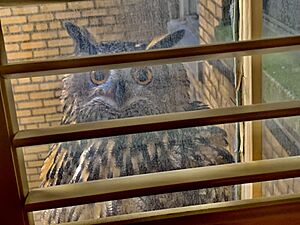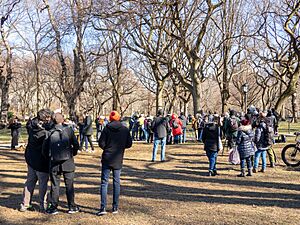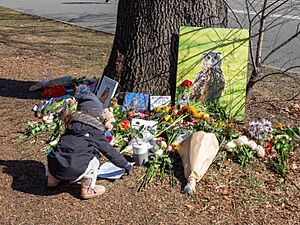Flaco (owl) facts for kids
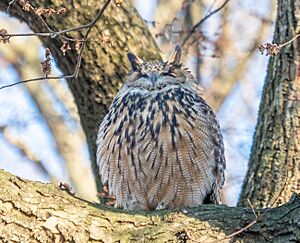
Flaco roosting in Central Park
|
|
| Species | Eurasian eagle-owl |
|---|---|
| Sex | Male |
| Hatched | March 15, 2010 Scotland Neck, North Carolina, U.S. |
| Died | February 23, 2024 (aged 13) Upper West Side, New York City, U.S. |
| Known for | Escape from the Central Park Zoo |
| Residence | Central Park |
Flaco (born March 15, 2010 – died February 23, 2024) was a male Eurasian eagle-owl. He became famous after escaping from the Central Park Zoo in New York City in February 2023. Someone cut the netting of his home, allowing him to fly free.
Flaco then lived in and around Central Park. His escape caught a lot of public and news attention. People were especially interested because he was an owl species not naturally found in North America. Many worried if he could find food after living in captivity for so long. But just a week after his escape, he was seen successfully catching and eating rats.
Zoo staff tried to catch Flaco, but they failed. Many people signed a petition asking for him to stay free. The zoo stopped trying to catch him once they saw he was eating regularly and flying well.
Even though he could hunt, there were worries about dangers in the park. For example, rodenticide (rat poison) could harm him. Flaco stayed in Central Park for nine months. Later, he started visiting nearby buildings and neighborhoods in Lower Manhattan. In February 2024, one year after his escape, Flaco died. He passed away after hitting a building in Manhattan's Upper West Side.
Contents
About Eurasian Eagle-Owls
The Eurasian eagle-owl (Bubo bubo) is a type of eagle-owl. These large owls live in many parts of Europe and Asia. They are one of the biggest owl species. Male owls can weigh from about 2.6 to 7 pounds. Their wingspan can be from 4 feet 3 inches to 6 feet 2 inches wide.
These owls have special ear tufts on their heads. Their upper feathers are spotted with dark blackish and brownish-yellow colors. Their wings and tail have stripes. The feathers on their belly are usually light brown with darker streaks.
Eurasian eagle-owls hunt at night. They mostly eat small mammals like rodents and rabbits. Sometimes, they also catch larger mammals and different kinds of birds. They live in many places, but they prefer mountainous or rocky areas. These places often have woodland edges, shrubs, or wetlands nearby where they can hunt. These owls can even live in city parks in their native lands. However, they are not naturally found in North America.
Flaco was born in a bird park in North Carolina in 2010. He moved to the Central Park Zoo later that same year. He lived at the zoo for over 12 years before he escaped. His home at the zoo was about the size of a bus stop. It had fake rocks, branches, and a painted background.
Flaco's Escape and Monitoring
On February 2, 2023, someone damaged Flaco's home at the zoo. The person or people responsible have not been caught. Flaco escaped through a hole in the exhibit's metal mesh. Zoo workers noticed he was gone around 8:30 PM.
The Wild Bird Fund, a wildlife hospital, told the police. NYPD officers tried to catch Flaco near the Bergdorf Goodman Building. But they were not successful. The next day, Flaco was found in a tree in the southern part of Central Park. For his first few days of freedom, he stayed in different parts of the park. This included the Hallett Nature Sanctuary and areas near the zoo.
Efforts to Recapture Flaco
Soon after Flaco escaped, zoo staff started trying to catch him. They watched him closely for several days. Owls are generally hard to catch. A common way to catch them is to use food to lure them. Zoo workers tried to attract Flaco with dead rats, but it didn't work.
Their first attempt used a bal-chatri trap. This trap has bait and is covered in wire loops. These loops can catch a bird's talons when it tries to get the food. They put the trap on the park's Heckscher Ballfields. Zoo staff hid nearby with nets. Flaco went for the rat and was briefly caught. But he managed to free himself quickly.
Staff then tried playing recordings of eagle-owl calls. They hoped this would attract him to other traps, but it also failed. The large crowds watching Flaco might have made him less likely to take food from the traps. Zoo employees were told not to talk to the news. However, some shared their frustration and tiredness anonymously in news reports.
Flaco's Survival in the Wild
Birdwatchers and zoo officials wondered if Flaco could survive. He had been in captivity for a long time. This meant he hadn't needed to practice flying or hunting. A person from the International Owl Center said his flying looked shaky at first. They also said he "looked stressed."
For his first few days, there were no reports of him eating. But on February 10, he was seen producing a pellet. An owl pellet is a ball of undigested animal parts that owls spit up after eating. This showed he had successfully hunted!
When people heard he could hunt, some started to argue against catching him. Activists used the hashtag #freeflaco on social media. They also started a petition to the zoo. The Wildlife Conservation Society (WCS) runs the Central Park Zoo. On February 12, WCS said their staff saw Flaco's flying skills improve. They also saw him successfully hunting and eating.
Since his survival was less urgent, WCS decided to change their plans. They worried that aggressive methods might scare him away. He might go to an area where he couldn't care for himself or be seen easily. So, WCS said they would reduce and change their efforts. Later that week, after another attempt with bait and owl calls failed, WCS stopped trying to catch him. Instead, they decided to just watch his well-being. They continued to do this for the rest of the year.
In November 2023, Flaco left Central Park for the first time since February. He was seen in a sculpture garden in the East Village. Later, he was spotted on the Lower East Side. His movement might have been caused by the New York City Marathon. Or it could have been from mobbing by crows. November is also part of the breeding season for his species. He might have been looking for a mate.
There are no wild Eurasian eagle-owls nearby. But there are great horned owls, a similar species. One of them, named Geraldine, often visits Central Park. Flaco returned to the park after a week. But he made more trips outside. This included several stops outside windows of city buildings. The Wall Street Journal joked that he was a "peeping tom". This was because Flaco was recorded many times staring through people's windows. This included the window of playwright Nan Knighton.
Public Interest in Flaco
People quickly became very interested in Flaco. This led to national news coverage. He was compared to other famous New York City "celebrity" birds. One example is the mandarin duck seen in Central Park in 2018. Zeynep Tufekci of The New York Times called Flaco "the Ultimate New Yorker."
Many city residents live in small apartments. They saw their own wish for more space in Flaco. Others felt connected to his need to adapt to city life. Immigrants saw their own struggles in Flaco's story. The New York Times' Ed Shanahan said people wanted to support Flaco. He was "a feathered feel-good figure in troubled times." Writer Michiko Kakutani said Flaco's story was truly American. He was an "outlaw-hero" who succeeded in "writing a second act to his life." Juliana Kim of NPR wrote that Flaco "became a sort of symbol for freedom and resilience."
Flaco became a popular spot for tourists. It was also a place for people to meet and socialize. Defector wrote that "friendships and romances were forged at the foot of Flaco's trees." A French newspaper, Le Monde, said Flaco was "worth the journey." They said his story was "worthy of a Walt Disney screenplay." Many artists painted pictures of Flaco. Poets wrote poems about him, and musicians wrote songs. Some people even got tattoos of him.
Zoo officials and some birdwatchers did not like that Flaco's location was shared on social media. Sharing the location of owls is a debated topic among birdwatchers. This is especially true in New York City. Owls like Flaco hunt at night. They rest during the day. Large crowds can disturb their rest. This is especially true if people don't follow birdwatching rules. For example, getting too close or making loud sounds for a photo. Many people might have made him more visible to prey. Or to birds that mob (attack) owls. This could have made it harder for him to hunt or rest.
Safety Concerns and Flaco's Death
Flaco was good at hunting, but living in Central Park had other risks. These included car traffic, rodenticide (rat poison), and hitting windows. In 2021, another Eurasian eagle-owl escaped from a zoo in Minnesota. It died in a road accident two weeks later.
Rats are common prey for owls. But rat poison is widely used in the city. This has made poisoning a common cause of death for raptors (birds of prey). Another owl, a barred owl named Barry, died in the park in 2021. She hit a maintenance vehicle. She might have been affected by rat poison inside her. The Central Park Conservancy, which manages the park, said it was not using rat poison. But rat poison is still used in the areas around the park.
Flaco's trips outside the park starting in November 2023 brought back fears. He could be harmed by rat poison or vehicles. Both are more common outside the park. The National Audubon Society wrote an article about Flaco. It said people should think about Flaco's well-being. But they should also think about native bird species he might eat. Another Audubon person said Flaco's fame could help other birds. He was an example of "charismatic megafauna" (popular animals). He could inspire people to care about other wildlife.
On February 23, 2024, Flaco was found on the ground on West 89th Street. He was badly hurt. Volunteers from the nearby Wild Bird Fund came to help. Flaco was pronounced dead soon after. Volunteers reported injuries on his chest and right eye. He had hit the building, getting hurt from the crash or the fall.
A special examination (called a necropsy) was done by the Bronx Zoo. It showed that Flaco had harmful levels of rat poison in his body. He also had pigeon herpesvirus. He got these from eating poisoned rats and feral pigeons. The virus caused a lot of damage and swelling in his organs. This made him weak. Because he was weak, he was more likely to hit a building. The WCS said these conditions were serious enough to kill him, even without the collision.
Flaco's Legacy
After Flaco died, people started leaving photos, cards, and other items. They placed them under an oak tree where Flaco often rested. Hundreds of his followers gathered for a memorial service at the tree. People spoke about him, sang, and read letters and poems. Flaco's remains were given to the American Museum of Natural History.
Flaco's death brought more attention to building rules. These rules aim to make windows safer for birds. New York City set strict standards in 2019. A bill in the New York Legislature wants to require more bird-friendly designs statewide. This bill was renamed the FLACO Act shortly after Flaco's death.
On the TV show Saturday Night Live, Sarah Sherman played Flaco's widow. This was during a segment called Weekend Update. It happened after the results of Flaco's necropsy were announced.
See also
- Birding in New York City
- Gladys (owl)
- Light pollution
- List of individual birds


